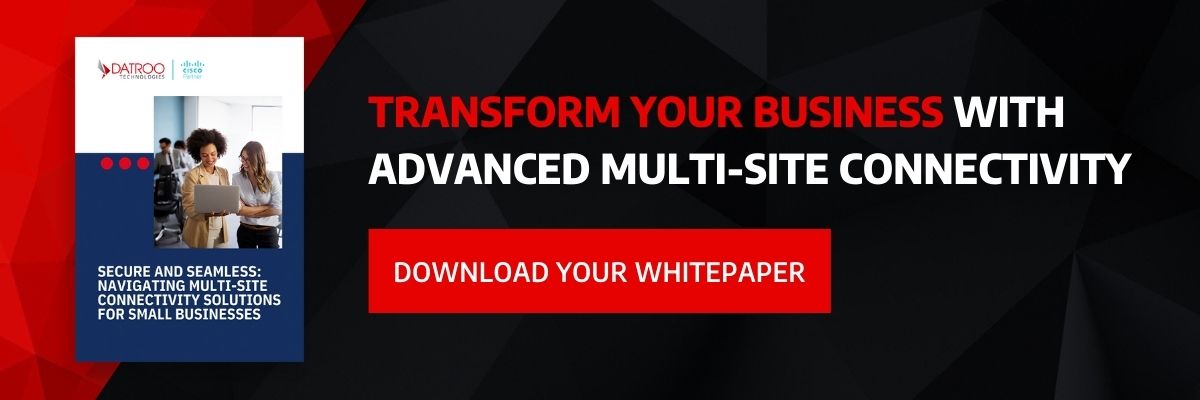
From Blueprint to Bandwidth: IT Planning for a New Office
In an era where technology underpins every facet of business operations, expanding your office’s physical space without a concurrent expansion of your IT infrastructure is akin to building a new skyscraper on an old, shaky foundation. It’s not just about adding more cables and computers; it’s about envisioning how technology will empower your business tomorrow, next year, and beyond. This blog is crafted for IT professionals who are at the helm of steering their small businesses through the choppy waters of IT planning for new office expansion. It’s about making informed decisions that align with your business’s growth trajectory, ensuring that your IT infrastructure is not just a support system, but a growth engine for your enterprise.
Understanding Your IT Needs When Planning For a New Office
In the realm of business growth and expansion, understanding your IT infrastructure is foundational. It’s about knowing where you stand today and anticipating where technology will need to support you tomorrow. Let’s explore how to assess your current setup and project your future IT requirements.
Assessing Current Infrastructure
A thorough examination of your existing IT framework is crucial to identify strengths, weaknesses, and opportunities for improvement. Here’s how to approach it:
- Inventory Analysis: Start by cataloging every piece of your IT puzzle. From hardware like servers and workstations to software applications and network configurations, understanding what you have is the first step.
- Performance Evaluation: Assess how well your current setup meets your operational needs. Are your systems reliable, fast, and scalable? Do they provide the data security and user experience your business requires?
- Alignment with Business Goals: Every piece of your IT infrastructure should serve a purpose towards achieving your business objectives. Identify any misalignments or areas where IT is not effectively supporting your strategic goals.
- Identify Gaps and Overlaps: Look for areas where your IT is lacking—be it in capabilities, capacity, or security. Similarly, identify redundancies where resources could be better utilized or streamlined for efficiency.
Projecting Future Requirements
Understanding what you need today is only half the battle. The next step is to anticipate the future needs of your business:
- Scalability Planning: As your business grows, so too will your IT demands. Consider how your current setup can scale. Will you need more robust servers, additional data storage, or more sophisticated software solutions?
- Market Expansion Considerations: If your business plans to enter new markets, what IT support will this require? Think about language-specific software, compliance with local data regulations, and the infrastructure needed to support operations in new territories.
- Remote Work Adaptability: The shift towards remote work continues to influence IT needs. Evaluate your infrastructure’s ability to support a distributed workforce, including secure remote access, collaboration tools, and communication systems.
- Emerging Technology Trends: Stay informed about technology trends that could impact your industry. Whether it’s artificial intelligence, blockchain, or the Internet of Things (IoT), understanding these trends can help you position your IT infrastructure for future opportunities.
By methodically assessing your current IT infrastructure and thoughtfully projecting future requirements, you’ll ensure your technology not only meets today’s needs but is also prepared to support tomorrow’s ambitions.

Designing Your IT Infrastructure
When designing IT infrastructure for a new office expansion, it is essential to craft a design that meets today’s needs while anticipating future growth is a strategic endeavor. It requires a balance between seamless integration with existing systems and the agility to scale as your business evolves. Here’s how to build an IT setup that’s both robust and adaptable.
Integration and Scalability
Creating an IT environment that’s both cohesive with current operations and adaptable to future changes is vital:
- Seamless System Integration: Begin by ensuring new technologies complement and enhance your existing IT landscape. This might involve compatibility assessments and integration testing to guarantee smooth operations.
- Flexible Scaling Options: Embrace solutions that offer scalability, such as cloud services that allow you to adjust resources based on demand. Consider the scalability of network infrastructure, storage capacity, and processing power to ensure they can expand in line with your business.
- Modular Hardware and Software Choices: Opt for modular hardware and software that can be easily upgraded or expanded. This approach allows you to add capabilities without overhauling your entire system, providing cost-effective scalability.
- Future-proofing Strategies: Invest in technologies that are poised to evolve. This includes adopting standards and platforms known for their long-term support and updates, ensuring your IT infrastructure remains relevant.
Key Elements of a Modern IT Setup
A modern IT infrastructure should empower your business with speed, reliability, and collaboration capabilities:
- High-Speed Connectivity: Prioritize high-speed internet and robust networking solutions to ensure seamless data flow and connectivity within your organization and with external partners.
- Reliable Data Storage Solutions: Implement data storage solutions that offer not just capacity, but also reliability and accessibility. This might include a mix of on-premises, cloud, and hybrid storage solutions to balance cost, performance, and security.
- Advanced Security Measures: With the increasing sophistication of cyber threats, your IT setup must include advanced security protocols, regular updates, and proactive threat monitoring to safeguard your data and systems.
- Collaborative Tools and Platforms: Adopt collaborative tools that facilitate real-time communication, project management, and document sharing, especially important for supporting remote or hybrid work models.
- User-Centric Design: Ensure that the IT infrastructure is designed with the end-user in mind, providing intuitive interfaces and user-friendly tools that enhance productivity and satisfaction.
By focusing on these critical areas, you can design an IT infrastructure that not only meets the immediate operational needs of your new office but also lays a solid foundation for future growth and innovation.
Network Infrastructure and Connectivity
In today’s interconnected business environment, the backbone of any successful operation is its network infrastructure and connectivity. Choosing the right network solutions is paramount to ensuring not only the efficiency and reliability of your IT systems but also the flexibility to support both on-site and remote work scenarios. Let’s delve into the key considerations for establishing a robust network infrastructure.
Choosing the Right Solutions
Selecting the appropriate network technologies and solutions is essential for a seamless, scalable, and secure IT environment:
- Efficient Network Management Options: Consider advanced solutions like SD-WAN (Software-Defined Wide Area Network) for more efficient and flexible network management across various locations, enhancing bandwidth usage and improving network resilience.
- Cloud-Managed Networks: Platforms like Cisco Meraki offer simplified management of your entire network from a centralized cloud interface, providing ease of use, enhanced security, and scalability without the need for extensive on-site hardware.
- Bandwidth and Connectivity: Evaluate your bandwidth requirements based on current and projected data volumes to ensure your network can handle peak loads. This includes considering the type of data being transferred, the number of users, and the applications being used.
- Future-Proofing: Invest in network solutions that can adapt to evolving technologies and business needs. This might involve choosing hardware and software with forward-compatibility, ensuring your infrastructure can support future data demands and network protocols.
Remote and On-Site Access Considerations
In an era where flexible work arrangements are becoming the norm, your network infrastructure must accommodate both remote and on-site employees effectively:
- Secure Remote Access: Implement VPN (Virtual Private Network) solutions and other secure access technologies to ensure remote employees can access network resources safely, regardless of their location.
- Seamless Connectivity for On-Site Employees: For those on-site, ensure that the network provides reliable, high-speed connections to support intensive applications and collaborative tools without lag or downtime.
- Unified Communication Tools: Adopt communication platforms that integrate seamlessly with your network, allowing for smooth voice, video, and data sharing across the organization.
- Network Security Measures: Given the mix of remote and on-site access, robust security measures such as multi-factor authentication, end-to-end encryption, and continuous monitoring are essential to protect sensitive data and prevent unauthorized access.
By focusing on these critical aspects of network infrastructure and connectivity, you can create a resilient, efficient, and secure foundation that supports both the current and future needs of your business, regardless of where your team is working from.

Data Security and Compliance
In an era where digital threats are increasingly sophisticated and regulatory landscapes are ever-evolving, establishing a fortified data security posture and ensuring compliance with relevant regulations is not just advisable—it’s imperative. Your IT infrastructure must be built on a foundation of robust security measures and compliance protocols to protect sensitive information and maintain customer trust. Here’s how to approach these critical components.
Building a Secure Foundation
The cornerstone of any resilient IT infrastructure is its security framework. Implementing comprehensive security measures is vital to defend against a wide array of cyber threats:
- Advanced Security Solutions: Employ a multi-layered security approach that includes firewalls, intrusion detection systems (IDS), and intrusion prevention systems (IPS) to monitor and protect your network from malicious activities.
- Encryption and Data Protection: Utilize strong encryption standards for data at rest and in transit to ensure sensitive information is unreadable to unauthorized users, safeguarding it from interception and breaches.
- Regular Security Assessments: Conduct periodic security audits and vulnerability assessments to identify and remediate potential weaknesses in your IT infrastructure before they can be exploited.
- Employee Training and Awareness: Foster a culture of security awareness among your staff with regular training on best practices, phishing prevention, and the importance of strong password policies.
Navigating Compliance Requirements
Compliance with industry-specific regulations is not only a legal obligation but also a key factor in building trust with your clients and partners:
- Understanding Regulatory Frameworks: Familiarize yourself with the compliance requirements relevant to your industry, such as HIPAA for healthcare, GDPR for European data protection, or PCI DSS for payment card security.
- Implementing Compliance Controls: Integrate compliance measures into your IT infrastructure from the outset, including data access controls, audit trails, and secure data storage and transmission practices.
- Regular Compliance Reviews: Stay abreast of changes in regulatory standards and conduct regular reviews of your compliance posture to ensure ongoing adherence to all applicable laws and regulations.
- Data Privacy Policies: Develop clear data privacy policies that outline how customer data is collected, used, stored, and protected, ensuring transparency and reinforcing trust.
By prioritizing data security and regulatory compliance in the design and maintenance of your IT infrastructure, you not only protect your business from potential threats and legal ramifications but also establish a foundation of trust and reliability with your customers and stakeholders.
Vendor Selection
In the journey of expanding your office’s IT infrastructure, selecting the right vendors and service providers is a pivotal decision. These partnerships will not only influence the technological capabilities of your office but also its operational efficiency and future scalability. Understanding how to assess potential partners is crucial for making informed decisions that align with your business objectives.
Choosing the Right Partners
Identifying and selecting the most suitable IT vendors involves a thorough evaluation of their offerings, reliability, and alignment with your needs:
- Assessment of Technology Offerings: Scrutinize the vendors’ technology solutions to ensure they meet your specific requirements. This includes evaluating the quality, scalability, and security features of their products and services.
- Reputation and Reliability: Research each vendor’s track record, including their history of uptime, customer service responsiveness, and ability to deliver on their promises.
- Support Services: Consider the level of support offered. This encompasses the availability of technical assistance, the responsiveness of customer service, and the provision of training or resources to help you maximize your investment.
- Compatibility with Existing Systems: Ensure the vendor’s solutions are compatible with your current IT infrastructure to facilitate seamless integration and minimize disruption.
- Flexibility and Scalability: Choose partners that offer flexible solutions that can grow and adapt as your business evolves. This includes the ability to easily add or modify services as your needs change.
Why Datroo Fits the Bill
Datroo Technologies distinguishes itself as an ideal partner for expanding your IT infrastructure, thanks to our comprehensive approach to IT solutions and unwavering dedication to customer success:
- Comprehensive IT Solutions: Datroo offers a wide range of cutting-edge IT solutions tailored to meet the diverse needs of businesses. From advanced cybersecurity measures to scalable cloud services and robust networking infrastructure, our portfolio is designed to support every aspect of your IT expansion.
- Industry Expertise: With years of experience serving clients across various sectors, Datroo brings a wealth of industry-specific knowledge and insights, ensuring that our solutions not only meet but exceed your expectations.
- Commitment to Customer Success: At Datroo, our relationship with clients extends beyond mere transactions. We are committed to your long-term success, offering ongoing support, strategic advice, and customized solutions that drive tangible results.
- Proven Track Record: Our history of successful implementations, satisfied customers, and recognized excellence in the IT field speaks to our reliability and effectiveness as a partner.
In your quest for the ideal IT partner for your office expansion, consider how Datroo Technologies stands out for its comprehensive solutions, deep industry expertise, and a steadfast commitment to empowering your business’s growth and success. Contact us for a consultation to discuss your unique needs.

Case Study: A Real-Life Success Story
An oil and gas industry case study showcases Datroo’s proficiency in tackling IT hurdles during office expansions. A Texas-based drilling company grappling with connectivity challenges across multiple sites found a solution with Datroo. By adeptly implementing WAN, LAN, and Inner Office Routing at over 25 locations, and incorporating system redundancy to prevent downtime, Datroo demonstrated its dedication to ensuring smooth, continuous operations. The drilling company’s decision to engage Datroo for future IT enhancements reflects the deep trust and satisfaction clients hold in Datroo’s capabilities and reliability.
Conclusion: The Path Forward
As we wrap up this exploration of IT planning for new office expansions, it’s clear that the journey involves much more than just technical installations. It’s about strategically aligning your IT infrastructure with your business’s growth vision, ensuring security, and forging the right partnerships. Let’s recap the essential steps and delve deeper into the importance of proactive planning.
Recap of Key Takeaways
- Strategic Alignment with Business Goals: Your IT infrastructure should be a catalyst for growth, tailored to support your business’s objectives and expansion plans.
- Emphasis on Security: In an age where cyber threats are ever-present, embedding advanced security measures into your IT setup is non-negotiable.
- Choosing the Right Partners: The success of your IT expansion is heavily influenced by the expertise and reliability of the partners you choose.
Encouraging Proactive IT Planning
Adopting a forward-thinking approach to IT planning can set the stage for not only meeting today’s operational needs but also paving the way for future success:
- Anticipate Future Trends and Technologies: Stay informed about emerging technologies and industry trends that could impact your business. This foresight enables you to adapt and innovate ahead of the curve.
- Build for Scalability: Ensure your IT infrastructure is designed with flexibility in mind, allowing for easy adjustments and expansions as your business grows and evolves.
- Foster a Culture of Continuous Improvement: Encourage an organizational mindset that values ongoing evaluation and optimization of IT resources to enhance efficiency and productivity.
By embracing these principles, IT leaders can ensure that their technology infrastructure not only supports current operations but also drives future growth and innovation. The path forward in IT planning is one of strategic foresight, robust security, and dynamic partnerships, all of which are essential for navigating the complexities of office expansion and achieving long-term success.
Transform Your Connectivity
Unlock the full potential of your business with Datroo’s whitepaper, “Secure and Seamless: Navigating Multi-Site Connectivity Solutions for Small Businesses.” Gain invaluable insights into enhancing connectivity while ensuring top-notch security across all your locations. Perfect for businesses looking to grow or streamline their operations, this guide is your key to a more efficient, connected future. Download now and take the first step towards seamless connectivity.

